This post follows up post #14, The Next Big Thing.

In 1916, in circular #30 of South Africa’s Union Observatory , Robert T. A. Innes reported the discovery of a faint red star in Centaurus. This otherwise unremarkable star, more than 100 times too faint to be seen with the naked eye, attracted his attention because it was rapidly moving with respect to other stars in the same part of the sky. This large proper motion indicated that the star was almost certainly a close neighbor of the Sun, and in 1917, this suggestion was verified. The distance to the star was measured to be only 4.22 light years, closer to the Sun than any other known star. Its extremely faint appearance, in spite of its close proximity, made it the intrinsically least luminous star known to astronomy at that time.
Proxima Centauri, as the star was later named, is now known to be merely the nearest (and most famous) of the roughly 50 billion red dwarfs (also called M-dwarfs) which inhabit our galaxy.
What about planets? Is it possible to have a terrestrial planet in orbit around Proxima? Do red dwarfs have a shot at harboring life-bearing worlds? If such worlds exist can we detect them?
Yes.
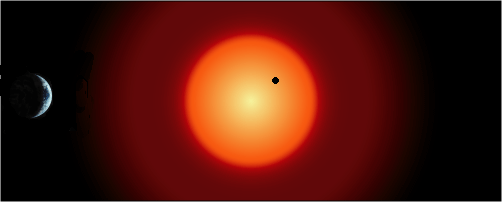
Red dwarfs are by far the most common type of star, and they differ fundamentally from the Sun in several ways. Proxima, for example, has about 11 percent of the Sun’s mass, and an average density several times that of lead (11.4 gm/cc). The Sun’s average density, on the other hand, is only 1.4 times that of water (1 gm/cc). Proxima’s total luminosity is about a thousand times less than the Sun, yet even this rather modest energy output has a difficult time escaping from Proxima’s interior. The center of Proxima is so opaque that radiation cannot efficiently transport all of the energy produced by fusion in the interior to the surface. Proxima must therefore resort to convection, a process in which the turbulent motion of stellar gas physically carries energy away from the center. Convection can be observed in a pot of water heated on a stove. Prior to the start of actual boiling, hot water wells up near the center of the pot, divests some of its heat, and then dives back down. (Convection also carries the energy through the outer two percent of the Sun’s mass, and the uppemost layer of convective cells are visible as granulation on the solar surface.)
Proxima’s whole interior is convective, and hence all the stellar material is continuously and thoroughly mixed. A helium nucleus forged in Proxima’s nuclear-burning core can expect to visit the surface regions within a relatively short time. This freedom of movement is in direct contrast to the interior of the Sun, where the core is radiative rather than convective. Helium that forms in the center of the Sun never strays far from its place of origin. The Sun’s core thus becomes slowly enriched in helium, while the original composition of the outer regions remains unaffected. The Sun can’t access its entire store of hydrogen, and this will profoundly shorten its productive, hydrogen-burning lifetime (The Sun’s steady increase in luminosity over the next few billion years will have drastic consequences for the Earth unless we do something about it.)
A completely convective low-mass star like Proxima, on the other hand, maintains access to its entire initial reserve of hydrogen fuel. Complete convection, coupled with an underwhelming power output, allows red dwarfs to survive almost unaltered, long after the higher mass stars have turned into white dwarfs, or self destructed in supernova explosions. Two trillion years from now, Proxima Centauri will still be shining, much as it shines today.
In 1997, Peter Bodenheimer, Fred Adams, and I used a stellar evolution code to explore the ultimate fate of red dwarfs such as Proxima. The figure just below is adapted from our paper. It indicates that a 0.1 solar mass star will live for about 6 trillion years before exhausting its hydrogen. Instead of becoming red giants, the lowest mass stars actually become dramatically brighter and bluer before ending their lives as helium white dwarfs.
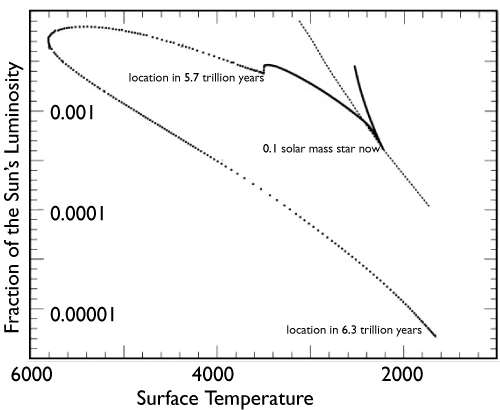
About 130 red dwarfs (nearly all of which are more massive than Proxima) are close enough to the Sun so that their apparent luminosity is bright enough (V<11) for them to be efficiently surveyed with the radial velocity method. These red dwarfs have been part of the California-Carnegie Planet Search list for about 8 years. To date, only one M-dwarf system (GJ 876) has been found to harbor Jupiter-mass planets. The occurrence rate of Jupiter-mass planets therefore seems to be roughly a factor of ten less for red dwarfs than for stars that are similar in mass to the Sun. Does this mean that red dwarfs don’t have many planets?
The fact that Jupiter-mass planets seem to be rare in orbit around red dwarf stars seems to be a natural consequence of the core accretion theory of planet formation. In the core-accretion theory, the formation of a giant planet occurs when a large core of solid material (with a mass of roughly ten times the Earth’s mass) rapidly accretes gas from the surrounding protostellar disk. The smaller the parent star, the longer it takes for the core to form, and in a protoplanetary disk surrounding a newborn red dwarf star, by the time the cores form, the gas has generally been lost. We predict, then, that Neptune-mass and smaller mass planets will be very common around red dwarfs, whereas Jupiter-mass planets will be quite rare. (Alan Boss, of the Carnegie Institute of Washington, has recently published a preprint that shows that if the alternate gravitational instability mechanism is the dominant mode of giant planet formation, then Jupiter-mass planets should be just as common around red dwarfs as they are around solar-type stars.)
There are now observational indications that suggest that low-mass planets may indeed be common around red dwarfs. The radial velocity surveys have recently reported the detection Neptune-mass companions in short-period orbits around the red dwarfs GL 581 and GL 436. A team of observers using the microlensing method have detected the signature what appears to be a planet with 5.5 Earth Masses orbiting a distant red dwarf.
What can we say about the properties of habtable planets orbiting red dwarfs? To fix ideas, lets imagine an Earth-sized world orbiting a star with a tenth of a solar mass.
A metal-rich 1/10th solar mass red dwarf has a radius about 1/10th of the Sun’s radius, and a surface temperature of about 2750 Kelvin (compared to 5800 Kelvin for the Sun). This radius and temperature gives the red dwarf about 1/2000th of thhe Sun’s energy output. Therefore, in order for our putative habitable world to receive the same amount of energy that Earth gets from the Sun, it needs to orbit at a distance of 0.022 AU. Kepler’s third law tells us that this corresponds to an orbital period of 3.85 days.
An Earth-like planet with a period of 3.85 days will be tidally locked to the red dwarf. In the absence of any significant perturbing bodies, its orbit will be almost perfectly circular, and its spin period will be the same as the orbital period. Like the Moon with respect to the Earth, the planet will always show one face to the red dwarf. One hemisphere will have an eternal day, the other hemisphere eternal night (to the extent that 6-odd trillion years counts as an eternity).
Naively, one might think that such a situation would be disastrous for planetary habitability. The lit side of the planet will bake, and the night side will be very cold. Worse yet, if the night side grows cold enough for the atmospheric gases to condense, then the resulting cold trap will rapidly render the planet airless and uninhabitable. Interestingly, however, simulations show that this situation will not occur. A 1997 study by Joshi et al used a global climate model to investigate how the Earth’s climate would respond if the Earth were tidally locked to the Sun. The results were encouraging: the substellar point on the surface was warmer than the Saharan Summer, and the antisolar point on the dark side was colder than the Antarctic Winter, but the atmosphere did not collapse. The oceans and atmosphere effectively transported heat from the day side to the night, and the tidally locked Earth remained habitable.
Do we expect habitable terrestrial planets to form around 0.1 solar mass stars? A planet with a 3.85 day period orbiting a 0.1 solar mass red dwarf is about 20 times closer to its parent star than Mercury is to the Sun. Is it reasonable to expect to find a planet orbiting this close? The answer seems to be yes. As a first piece of evidence, we have proof positive that the nearby 0.32 solar mass red dwarf GJ 876 is accompanied by a 7.5 earth mass planet with an orbit of only 1.9379 days.
UCSC graduate student Ryan Montgomery is currently carrying out an extensive set of computer calculations which simulate the accretion of terrestrial-mass planets from a large swarm of small planetesimals. He’s using the Wetherill–Chambers method, which has had good success in explaining the latter stages of formation of the terrestrial planets in our own Solar System. Ryan will be reporting the full details of this work at the March AbSciCon meeting in Washington DC. Suffice it to say here that his results are exciting and encouraging. As a representative example, the figure below shows the result of one of his simulations: the emergence of a single Earth-mass planet in orbit around a red dwarf. In this particular calculation, it was assumed that a Neptune-mass planet was able to form at a radial distance from the star of ~0.5 AU, beyond the so-called snow-line of the M-dwarf protostellar disk. The presence of the Neptune-mass perturber sculpts the evolution of the planetesimal population in an analogous manner to how Jupiter is thought to have affected the formation of the Solar System’s terrestrial planets.
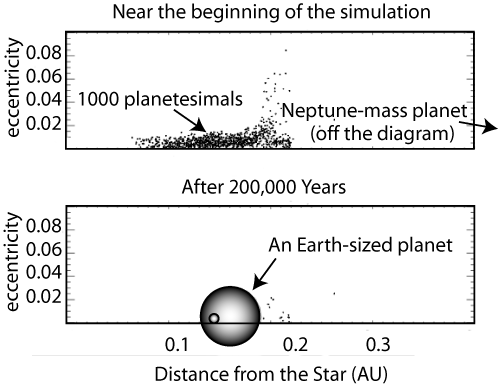
If habitable planets do commonly form in orbit around low mass red dwarfs, our chances of detecting and characterizing them are surprisingly good. Here’s the strategy:
The radius of a 0.1 solar mass star is roughly 10 times smaller than the Sun, and 10 times larger than the Earth. This means that the transit of an Earth-sized planet will block about 1% of the red dwarf’s light. For the example case of our planet on a 3.85 day orbit, the transit will be relatively brief, lasting about 40 minutes.
What are the chances that a transit will be visible? The actual to-scale geometry of a habitable Earth-sized planet orbiting a red dwarf looks like this:

The a-priori geometric probability that (given the presence of the planet) we can observe a transit is 2%. This implies that one out of 50 0.1 solar mass red dwarfs with a habitable planet displays transits.
In principle, a 1% photometric dip is readily detectable, and in fact, amateur astronomers who participate in the transitsearch.org collaboration routinely achieve detection thresholds of considerably better than 1%. The figure below shows Ron Bissinger’s observation of the transit of HD 149026 b, which has a transit depth of 0.3%, compared to the depth and duration of the transit of an Earth-sized planet. Skilled amateurs such as Bissinger or Tony Vanmunster have backyard techniques that are good enough to detect the passage of even a Mars-sized body in front of an 11th magnitude 0.1 solar mass red dwarf. Wow.
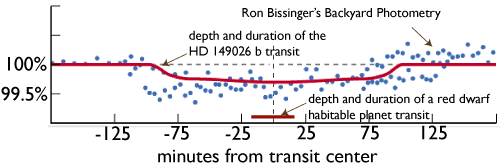
How many suitable red dwarfs are available on the sky? Even though the lowest-mass M stars are the most common type of star, they are also exceedingly dim. A 3m-class telescope, such as the Shane Reflector on Mt. Hamilton would be required to properly search the magnitude range V=16-18 where the lowest-mass red dwarfs begin to be plentiful (and indeed, many 0.1 solar mass stars within 10 parsecs still remain to be discovered). In the meantime, however, we recommend that observers immediately consider obtaining high-cadence photometry of the following nearby stars (selected from the RECONS catalog of the 100 nearest stellar systems maintained by Todd Henry and his collaborators at Georgia State University). We soberly estimate that each one has a ~1% chance of harboring a detectible transiting, potentially habitable planet!
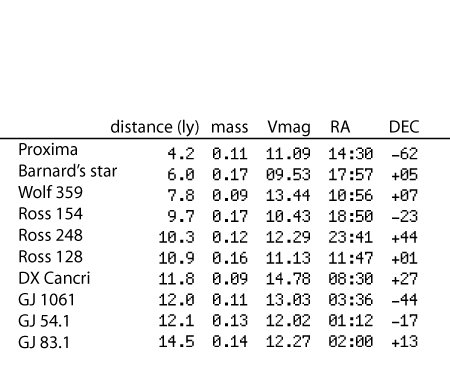
In a follow-up post, we’ll return with the full details of the observing strategy, as well as an overview of the implications of Ryan Montgomery’s latest simulations.

Pingback: Centauri Dreams » Blog Archive » A Close Look at Proxima Centauri
Hi Greg
Just one question about your data on Proxima. A couple of years ago the ESA released an observational study that gave Proxima’s mass as 0.123 solar and its radius about 0.145. Are they using a different stellar evolution code? If so, why?
Adam
Pingback: systemic - A Case for Habitable Planets Orbiting Red Dwarfs